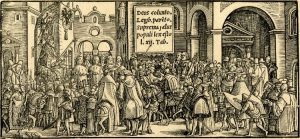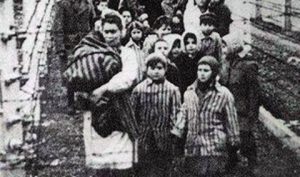As you are coming to the end of your long journey, you’re overwhelmed with the idea that you’ll be home soon, accompanied by warm, familiar faces. However, when you return home, you’re not welcomed by friends and family, but by silence and only the howl of the wind. You look around and not a single soul is in sight. Not one person in your home or in your whole village. A frightening scenario, isn’t it? This was the startling reality that John White and his fellow colonists were faced with when they returned home from their long voyage. His home was none other than the infamous Roanoke Colony.

In 1587, John White led 113 men, women, and children to Roanoke island on behalf of Queen Elizabeth I, in order to establish a New World colony, and claim riches for the queen and people of England.1 The land was somewhat familiar as it had been a previous military outpost.2 However, its first attempt at establishing a colony there had failed. John White and his men were determined not to fail their Queen on this attempt. They especially did not want to fail their investor, Sir Walter Raleigh, like others had in the past. So they went to all extents to make sure their colony’s needs were met.3 The colony seemed to settle well; however, they quickly outgrew supplies, which were essential for the long-term establishment of the colony; so now governor of Roanoke, John White, sailed back to England in order to restock. Upon his arrival in London, he was met with war with Spain and the Spanish Armada, England’s enemy at the time. Storms and many other factors made the return back to Roanoke a long one, one of years, leaving the colonists to wonder when their leader would return.4
Once John White and his men returned, Roanoke was bereft of all its colonists. They recalled that on their way to Roanoke, once already on land, they found a few footprints from Indians.5 However, they made nothing of it at the time. When they reached the village, White came across the letters “CRO” carved on a tree and the word “CROATOAN” carved on a post. Upon further inspection, it seemed that all the houses that the Roanoke Colonist were living in had been dismantled. After seeing this, White was more at ease because he believed that they had relocated to Croatoan, where the Croatoan tribe lived. This was due to the fact that White told the colonists that if they ever relocated, they were to carve the name of their new location somewhere visible. If the move or escape was out of distress, they were also to carve a Maltese cross, but none were in sight. One small thing bothered White though. He had told the colonists to hide his valuables underground, but he found that some were scattered and others were lost. In the end, for a reason unknown, White only looked for the colony one time, but didn’t find them. After this failed attempt, he made no others.6
One question still lingered in the mind of many others: what happened to the Roanoke colonists? It’s said that they were never seen again by Europeans, but there were also many speculated accounts of their whereabouts and fate. In 1608, John Smith wrote in his book that the Indians reported to him of people that looked like him. George Percy, another colonist, reported seeing a white boy with blonde hair among the Indians. Smith later sent two missions towards the south in order to find evidence of the remaining colonists, eventually learning that they were killed.7

Later, a twenty-one-quartz stone was discovered that is believed to have been a “grave marker” for the Roanoke deceased. On the smooth side of the stone was a cross and on the other were passages, speaking of deaths within the colony along with the years.8 As a last matter, in 1612, writer William Strachey reported that the Roanoke Colony did indeed live in harmony with the Chesapeake Indians for twenty-five years. Both the Indians and colonists shared knowledge and lived together until Powhatan, a leader of another Indian tribe called the Powhatan, slaughtered the colonists and the Indians sheltering them in fear that a rival to him would appear from within their tribe. A few of the colonists escaped and were later spared when they were found due to the fact that they worked well with copper, making them valuable. Still many wondered if these were facts or just stories that people wanted to hear.9 In the end, all the evidence points to the fact that the Roanoke colonists are not lost to history, but were rather killed off by brutal Indians. There is no mystery left, it’s just a matter of connecting the dots.
- The Gale Encyclopedia of the Unusual and Unexplained, 2003, s.v. “The Desertion of Roanoke,” by Brad Steiger and Sherry Hanson Steiger; Karenne Wood, “The Roanoke Colony,” South Atlantic Review 77, no. 1/2 (2012): 178-79. ↵
- Lee Miller, Roanoke Solving the Mystery of England’s Lost Colony (London: Pimlico, 2001), 7-9. ↵
- Karenne Wood, “The Roanoke Colony,” South Atlantic Review 77, no. 1/2 (2012): 178-79. ↵
- Lee Miller, Roanoke Solving the Mystery of England’s Lost Colony (London: Pimlico, 2001), 10-11. ↵
- Karen Odahl Kupperman, Roanoke The Abandoned Colony (New Jersey: Rowman & Allanheld, 1984), 133-135. ↵
- Karen Odahl Kupperman, Roanoke The Abandoned Colony (New Jersey: Rowman & Allanheld, 1984), 136-137. ↵
- Karen Odahl Kupperman, Roanoke The Abandoned Colony (New Jersey: Rowman & Allanheld, 1984), 137-139. ↵
- Haywood J. Pearce, “New Light on the Roanoke Colony: A Preliminary Examination of a Stone Found in Chowan County, North Carolina,” The Journal of Southern History 4, no. 2 (1938): 148-150. ↵
- Karen Odahl Kupperman, Roanoke The Abandoned Colony (New Jersey: Rowman & Allanheld, 1984), 139. ↵



114 comments
Angelo Oliva-Noeggerath
The introduction used in this Article is very well constructed and was able to intrigue me and want to learn of the situation that occurred! The historical factuality that was displayed in the Article and in-depth overview of the events that occurred were able to explain and detail the events as it had happened and even went more in-depth than the book did for this certain event.
Sabrina Drouin
I love how you put us into the shoes of John White in the first paragraph, it makes me feel like I was also experiencing coming home to my family not being home and really hooked me into keep reading. I also liked how you almost let us choose our own ending of this story, because some people can speculate what happened, but we will truly never know exactly what happened. This keeps us thinking as readers and ultimately keeps us hooked as readers to continue to think about what we think happened to them.
Aidan Fitzgerald
This story has always fascinated me because it continuously comes up in middle and high school classes as a mystery that the world has never solved. When frankly I never personally believed that this was the case. I had a hard time in middle school believing that a colony of over 100 people just magically vanished into thin air with very little trace but this article and the scenarios you describe using simple facts makes it seem very accurate. A large colony with its leader missing for a significant amount of time was certainly inevitable to be invaded by Native Americans. I am glad I read this article because it provides some clarity and some real life scenarios as to what happened to this colony of Europeans.
Jourdan Carrera
The author did a great job in displaying the original mystery of the colony to the reader which was excellent in capturing my attention. There was also great research done by the author when it came to the after effects of the lost colony, such as bringing up John Smith’s book from 1608 where the natives say that they had seen someone like him before. I also enjoyed the ending where the mystery is closed, so to speak, where the reader is presented with a logical explanation of what happened and given all the facts so that they might better understand the reading.
Mariah Podwika
As an avid watcher of FX’s show, American Horror Story, I had a little bit of knowledge about the Roanoke colony, but a lot of what that season of the show covers is purely folklore and ghost stories. The way that the author paints a picture of coming home from a long journey expecting to find everyone you love there and being greeted by emptiness is heartbreaking and chilling. The idea that a colony growing so much and thriving after so much failure in the past could disappear seemingly overnight is somewhat a true horror story.
Amelie Rivas-Berlanga
The introduction was great! Showing the POV of what White would have seen. The markings and symbols they left behind as a last precaution, because they did not know would happen to them. It makes you think about how they killed them or what they made them do before murdering them. It is a great story to keep the reader questioning what really happened to the colony.
Alaina De Leon
Having my knowledge been from the tv American Horror Story on this topic I felt it was necessary to read a little more about the story that happened so long ago. This chilling case of a missing colony makes you think how it is possible and tragic.It leads me to think that the colony was murdered horrifically and covered up but who is to say for sure what went down.This is a great article and I enjoy reading mysteries that make me think and try to come up with my own theory.as to what happened.
Elliot Avigael
I got chills sent up my spine reading this. It’s almost like something out of a horror movie; totally creepy.
It’s just hard to believe that such people would disappear without a trace. And leaving code words and symbols on top of that makes it all the more mysterious. It is likely that the colony was abandoned or the local were murdered by neighboring tribes, but nonetheless, the thought of how thriving settlements could become abandoned from one day to the next is chilling.
Madeline Emke
I enjoyed how the author, while displaying his own thoughts from the evidence, ultimately left the conclusion of the Roanoke Colony to the reader. One thing I noticed is that the author mostly focused on the conclusion he believed was the most likely to have happened while there are actually a couple possible explanations that historians believe could have happened. Overall, the article was extremely well-written and informative.
Madeline Chandler
Such a well written article! Extremely interesting and informative. I had previously known some about the stories of Roanoke yet I not in this depth or this idea of it. The concept that all of the settlers could have been all killed by native americans makes one think what if that happened at other times. This wretched theory is devastating. Also, there could have been a chance that the settlement of Roanoke could have survived under different circumstance. Great job, I thoroughly enjoyed reading your article.